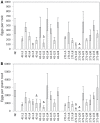Molecular characteristics and efficacy of 16D10 siRNAs in inhibiting root-knot nematode infection in transgenic grape hairy roots
- PMID: 23874962
- PMCID: PMC3712915
- DOI: 10.1371/journal.pone.0069463
Molecular characteristics and efficacy of 16D10 siRNAs in inhibiting root-knot nematode infection in transgenic grape hairy roots
Abstract
Root-knot nematodes (RKNs) infect many annual and perennial crops and are the most devastating soil-born pests in vineyards. To develop a biotech-based solution for controlling RKNs in grapes, we evaluated the efficacy of plant-derived RNA interference (RNAi) silencing of a conserved RKN effector gene, 16D10, for nematode resistance in transgenic grape hairy roots. Two hairpin-based silencing constructs, containing a stem sequence of 42 bp (pART27-42) or 271 bp (pART27-271) of the 16D10 gene, were transformed into grape hairy roots and compared for their small interfering RNA (siRNA) production and efficacy on suppression of nematode infection. Transgenic hairy root lines carrying either of the two RNAi constructs showed less susceptibility to nematode infection compared with control. Small RNA libraries from four pART27-42 and two pART27-271 hairy root lines were sequenced using an Illumina sequencing technology. The pART27-42 lines produced hundred times more 16D10-specific siRNAs than the pART27-271 lines. On average the 16D10 siRNA population had higher GC content than the 16D10 stem sequences in the RNAi constructs, supporting previous observation that plant dicer-like enzymes prefer GC-rich sequences as substrates for siRNA production. The stems of the 16D10 RNAi constructs were not equally processed into siRNAs. Several hot spots for siRNA production were found in similar positions of the hairpin stems in pART27-42 and pART27-271. Interestingly, stem sequences at the loop terminus produced more siRNAs than those at the stem base. Furthermore, the relative abundance of guide and passenger single-stranded RNAs from putative siRNA duplexes was largely correlated with their 5' end thermodynamic strength. This study demonstrated the feasibility of using a plant-derived RNAi approach for generation of novel nematode resistance in grapes and revealed several interesting molecular characteristics of transgene siRNAs important for optimizing plant RNAi constructs.
Conflict of interest statement
Figures




Similar articles
-
Engineering broad root-knot resistance in transgenic plants by RNAi silencing of a conserved and essential root-knot nematode parasitism gene.Proc Natl Acad Sci U S A. 2006 Sep 26;103(39):14302-6. doi: 10.1073/pnas.0604698103. Epub 2006 Sep 19. Proc Natl Acad Sci U S A. 2006. PMID: 16985000 Free PMC article.
-
Effective approaches to study the plant-root knot nematode interaction.Plant Physiol Biochem. 2019 Aug;141:332-342. doi: 10.1016/j.plaphy.2019.06.009. Epub 2019 Jun 9. Plant Physiol Biochem. 2019. PMID: 31207494 Review.
-
Host-delivered RNAi: an effective strategy to silence genes in plant parasitic nematodes.Planta. 2007 Nov;226(6):1525-33. doi: 10.1007/s00425-007-0588-x. Epub 2007 Jul 25. Planta. 2007. PMID: 17653759
-
Tobacco rattle virus mediates gene silencing in a plant parasitic root-knot nematode.J Exp Bot. 2009;60(14):4041-50. doi: 10.1093/jxb/erp237. Epub 2009 Jul 22. J Exp Bot. 2009. PMID: 19625337
-
Biotechnological application of functional genomics towards plant-parasitic nematode control.Plant Biotechnol J. 2011 Dec;9(9):936-44. doi: 10.1111/j.1467-7652.2011.00601.x. Epub 2011 Feb 25. Plant Biotechnol J. 2011. PMID: 21362123 Review.
Cited by
-
Peat-based hairy root transformation using Rhizobium rhizogenes as a rapid and efficient tool for easily exploring potential genes related to root-knot nematode parasitism and host response.Plant Methods. 2023 Mar 4;19(1):22. doi: 10.1186/s13007-023-01003-3. Plant Methods. 2023. PMID: 36871001 Free PMC article.
-
Host-Induced Silencing of Two Pharyngeal Gland Genes Conferred Transcriptional Alteration of Cell Wall-Modifying Enzymes of Meloidogyne incognita vis-à-vis Perturbed Nematode Infectivity in Eggplant.Front Plant Sci. 2017 Mar 30;8:473. doi: 10.3389/fpls.2017.00473. eCollection 2017. Front Plant Sci. 2017. PMID: 28424727 Free PMC article.
-
Identification and functional analysis of secreted effectors from phytoparasitic nematodes.BMC Microbiol. 2016 Mar 21;16:48. doi: 10.1186/s12866-016-0632-8. BMC Microbiol. 2016. PMID: 27001199 Free PMC article. Review.
-
The status of RNAi-based transgenic research in plant nematology.Front Microbiol. 2015 Jan 12;5:760. doi: 10.3389/fmicb.2014.00760. eCollection 2014. Front Microbiol. 2015. PMID: 25628609 Free PMC article. Review.
-
Silencing efficiency of dsRNA fragments targeting Fusarium graminearum TRI6 and patterns of small interfering RNA associated with reduced virulence and mycotoxin production.PLoS One. 2018 Aug 30;13(8):e0202798. doi: 10.1371/journal.pone.0202798. eCollection 2018. PLoS One. 2018. PMID: 30161200 Free PMC article.
References
-
- Nicol JM, Stirling GR, Rose BJ, May P, Van Heeswijck R (1999) Impact of nematodes on grapevine growth and productivity: current knowledge and future directions, with special reference to Australian viticulture. Australian Journal of Grape and Wine Research 5: 109–127.
-
- Cousins P, Johnston D, Switras-Meyer S, Boyden L, Vidmar J, et al. (2007) USDA ARS research in grape rootstock breeding and genetics. Acta Hort (ISHS) 733: 51–58.
-
- Cousins P, Walker MA (2002) Genetics of resistance to Meloidogyne incognita in crosses of grape rootstocks. Theor Appl Genet 105: 802–807. - PubMed
-
- Xu K, Riaz S, Roncoroni NC, Jin Y, Hu R, et al. (2008) Genetic and QTL analysis of resistance to Xiphinema index in a grapevine cross. Theor Appl Genet 116: 305–311. - PubMed
Publication types
MeSH terms
Substances
Grants and funding
LinkOut - more resources
Full Text Sources
Other Literature Sources
Miscellaneous

